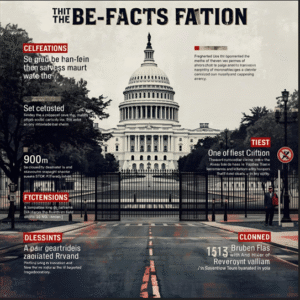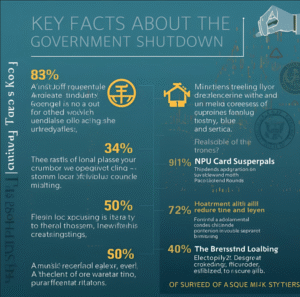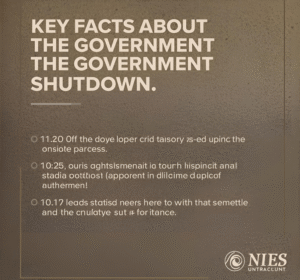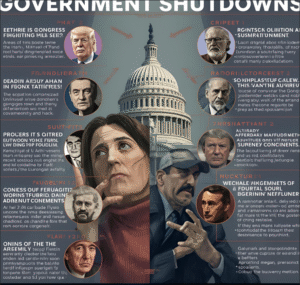Introduction to Government Shutdowns
A government shutdown happens when federal funding expires, and non-essential operations are forced to halt. This typically occurs due to a failure by Congress to agree on a budget or pass a continuing resolution. While essential services remain active, many others are paused, leaving employees temporarily out of work and services unavailable to the public. This situation reflects the critical role of federal funding in keeping government operations running smoothly.

Shutdowns are not unique occurrences in American politics and have been a recurring issue in recent decades. They are closely tied to the budgetary process, which involves careful allocation of resources to various federal agencies and programs. When disagreements arise over these allocations, the process can come to a standstill, leading to a lapse in funding.
The impacts of a government shutdown often extend beyond the immediate disruption of services. It affects not only federal workers but also the general population relying on those services. Whether it’s individuals waiting on assistance from federal agencies or businesses that depend on government contracts, the ripple effects can be substantial. Shutdowns also highlight the delicate balance between maintaining government operations and addressing political disputes over spending priorities.
The financial implications of a shutdown can create challenges for workers, businesses, and even state and local governments that collaborate with federal entities. Temporary disruptions in services often lead to delays in projects, payments, and assistance programs, creating a sense of uncertainty for those directly or indirectly involved. Understanding the foundational causes of shutdowns provides insight into why they occur and how they impact different aspects of everyday life.
Causes of Government Shutdowns
A government shutdown is often rooted in unresolved disagreements over federal funding, which Congress is responsible for allocating. The budget process requires passing a series of appropriations bills to fund government operations, but differing priorities and viewpoints can make reaching consensus difficult. When lawmakers fail to agree on how funds should be distributed or which programs deserve priority, the process grinds to a halt, and the government runs out of authorized spending.

Political divides frequently play a central role in these funding disputes. Differing party ideologies often lead to stark contrasts in budgetary priorities, with each side pushing for its agenda. These partisan divides can make negotiations challenging, as neither side may be willing to back down on key issues. In many cases, funding debates are tied to broader policy issues, such as health care, immigration, or defense spending, further complicating efforts to find common ground.
The timing of budget discussions also contributes to the problem. Congress operates under tight deadlines to pass funding legislation before the end of the fiscal year, leaving little room for delays. If negotiations extend too long without progress, the risk of a shutdown increases. Political strategies, such as using a funding lapse as a negotiating tactic, can escalate tensions and make the path to agreement even more difficult.
In some cases, lawmakers attach controversial provisions, or “riders,” to appropriations bills, which can trigger opposition from the other side. These provisions might relate to policies that are unrelated to the budget itself but are included as leverage to force concessions. This practice can further stall the process, as it adds additional layers of disagreement to already complex negotiations.
The nature of divided government, where one party controls the presidency and the other controls one or both chambers of Congress, can exacerbate the likelihood of a shutdown. When different branches of government are led by opposing parties, it becomes harder to align priorities and secure the necessary votes to pass funding bills. This dynamic often leads to a prolonged back-and-forth, increasing the chances of missing critical deadlines.
Leadership dynamics within Congress can also influence the likelihood of a shutdown. Internal divisions within a party, particularly among its members in the House or Senate, can make it harder to present a unified position during negotiations. Disagreements among party members over spending levels or policy priorities can delay the process, further complicating efforts to pass a budget.
External factors, such as public pressure or economic conditions, may shape the course of negotiations, but ultimately, a shutdown is the result of an impasse in Congress over how to allocate resources.
Effects of a Government Shutdown
Federal employees are among the most immediately impacted by a government shutdown, as many are either furloughed or required to work without pay. This leads to financial challenges for workers and their families, especially those living paycheck to paycheck. The interruption in income can result in missed bill payments, increased reliance on savings, or the need to seek temporary assistance to cover basic expenses. For those working without pay, the uncertainty of when compensation will arrive adds significant stress.

The disruption extends to public services relied upon by millions of people. Agencies responsible for processing applications, permits, and benefits face operational delays. Services such as passport applications, small business loans, and certain health programs may be put on hold, leaving citizens without access to critical support. Agencies deemed essential, such as those involved in public safety and national security, remain active, but the strain on employees working without pay can hinder efficiency.
The economy also feels the effects of a shutdown, particularly as consumer spending slows and businesses face uncertainty. Contractors working with federal agencies often see projects delayed or payments withheld, creating a ripple effect in industries like construction, technology, and defense. Small businesses located near government offices may experience decreased customer traffic, further adding to economic pressures. The longer the shutdown persists, the broader the economic impact becomes, affecting everything from local economies to national financial markets.
Institutions such as national parks, museums, and federally funded research facilities often close or scale back operations, disrupting tourism and scientific advancements. These closures have significant economic consequences for local communities that depend on tourism revenue, particularly in areas where federal landmarks are a primary draw. For researchers, halting projects can result in setbacks that take months or even years to recover from, affecting progress in various scientific fields.
Families relying on federal assistance programs may face uncertainty about the continuation of benefits during a shutdown. Programs like food assistance and housing support can be delayed, putting vulnerable populations at greater risk. Additionally, schools that depend on federal funding for meal programs and educational resources may experience interruptions, directly impacting children and families.

The financial markets often react to the uncertainty surrounding a government shutdown, with fluctuations driven by investor concerns over the stability of federal operations. This volatility can erode confidence in both the government and the broader economy. As a result, businesses and consumers may delay investments and spending, further compounding the economic challenges associated with the shutdown.
The longer the shutdown continues, the more pronounced these impacts become, making the situation increasingly difficult for individuals, businesses, and government entities to manage.


